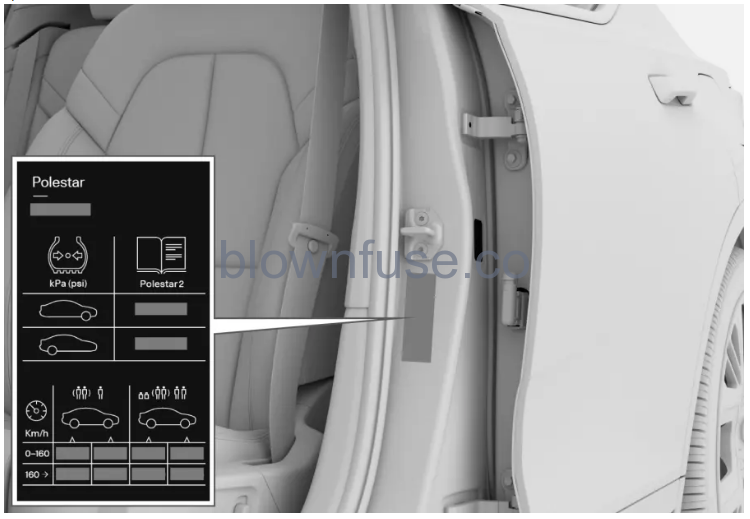2022 Polestar 2 Tire inflation pressure

Adjusting tire pressure
- Tire pressure decreases over time, which is normal. The tire pressure must therefore be adjusted to maintain the recommended tire pressure.
- Use the recommended inflation pressure for cold tires to help maintain good tire performance and even wear.
To help prevent incorrect inflation pressure, pressure should be checked when the tires are cold. The tires are considered to be cold when they have reached the same temperature as the ambient temperature (about 3 hours after the vehicle was last driven). After driving for a few kilometers, the tires will warm up and the pressure will increase.
- Remove the valve cap from the tire and press the air pressure gauge firmly onto the valve.
- Inflate the tire to the correct inflation pressure; see the tire pressure placard on the driver’s side B pillar for recommended pressures for factory-mounted tires.
- Screw the valve cap back on.
- After inflating a tire, always replace the valve cap to help prevent valve damage caused by gravel, dirt, etc.
- Only use plastic valve caps or original Polestar valve caps.
- Visually inspect the tire to make sure there are no nails or other embedded objects that could puncture the tire and cause air leakage.
- Check the sidewalls to make sure there are no gouges, cuts, bulges or other irregularities.
- Repeat this for all tires.
- If you have overfilled the tire, release air by pushing on the metal stem in the center of the valve. Then recheck the pressure with your tire gauge.
- Some spare tires require higher inflation pressure than the other tires. Consult the tire inflation pressure table or the inflation pressure decal.
Checking tire pressure
- Correct inflation pressure helps improve driving stability, save energy consumption and increase the service life of the tires.
- Tire pressure decreases over time, which is normal. Tire pressure also varies depending on the ambient temperature. Driving on under-inflated tires could cause the vehicle to overheat and lead to damage.
- Tire pressure affects traveling comfort, road noise and driving characteristics.
- Check the pressure in the tires every month. Use the recommended inflation pressure for cold tires to help maintain good tire performance. Under-inflated or over-inflated tires could cause uneven tread wear.
- Use an air pressure gauge and check the inflation pressure on all the tires at least once a month and before long trips. Polestar recommends buying a reliable air pressure gauge, as the automatic gauges provided at service stations may be inaccurate.
- Under-inflation is the most common cause of tire failure and may result in severe tire cracking, tread separation, or “blow-out,” with unexpected loss of vehicle control and increased risk of injury.
- Under-inflated tires reduce the load-carrying capacity of your vehicle.
Cold tiresInflation pressure should be checked when the tires are cold. The tires are considered to be cold when they have the same temperature as the surrounding (ambient) air. This temperature is normally reached after the vehicle has been parked for at least 3 hours.
After driving for approximately 1.6 km (1 mile), the tires are considered to be warm. If you need to drive longer than that to inflate the tires, check and record the inflation pressure of the tires first and inflate accordingly when you arrive at the pump.
When the ambient temperature changes, so does the inflation pressure. A 10-degree temperature drop causes a corresponding drop in inflation pressure of 7 kPa (1 psi). Check the inflation pressure of the tires regularly and adjust to the correct pressure, which can be found on the vehicle’s tire information decal or certification label.
If you check inflation pressure when the tires are warm, you should never release air. The tires become warm after driving and it is normal for warm tires to have an inflation pressure above the recommended pressure for cold tires. A warm tire with an inflation pressure equal to or under the recommended pressure for cold tires could be significantly under-inflated.
Recommended tire pressure

- Location of tire pressure sticker
- The decal specifies the designation for the factory-mounted tires on the vehicle, as well as load limits and inflation pressures.
The decals shown in the Manual do not claim to be exact reproductions of those found in the vehicle. The purpose is to show approximately how they look and about where they are located on the vehicle. The information that applies for your vehicle in particular is found on the decal on the vehicle.

